
Larimar Gemstone: Price, Meanings, Healing Uses & More
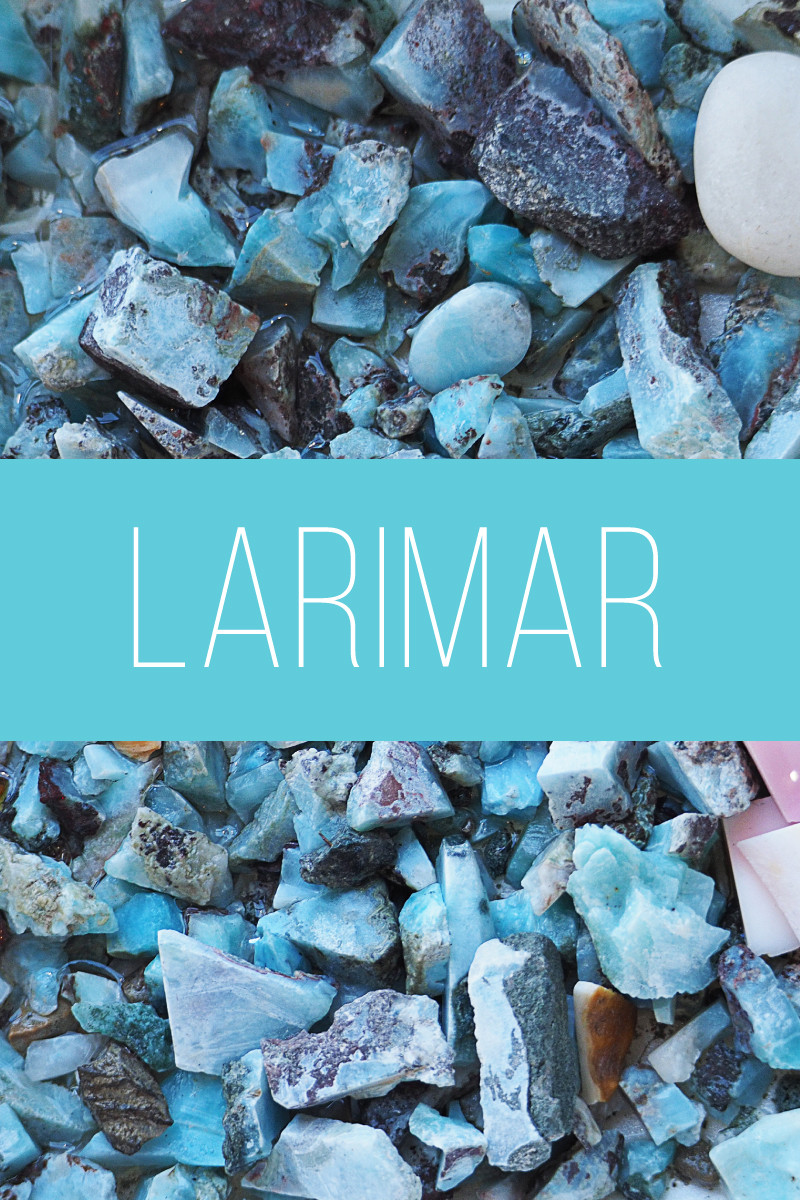 Larimar (or lorimar) is a rare blue to sea green gemstone variety of pectolite. This coveted gem only comes from the Dominican Republic, and it’s one of the rarest gemstones on Earth.
Larimar (or lorimar) is a rare blue to sea green gemstone variety of pectolite. This coveted gem only comes from the Dominican Republic, and it’s one of the rarest gemstones on Earth.
The stone’s visual and spiritual qualities have abundant oceanic connections. Many larimar stones have white splotches around the ultramarine hues, resembling a spume (the white, frothy foam on top of waves) or a cloudy day at sea.
Given larimar’s rarity, gorgeous colors, and cultural history, it holds a place in our top 10 gemstones of all time.
Ready to learn about this beautiful blue stone from the Dominican Republic? Come aboard as we set sail to uncover larimar gemstone history, value, healing properties, and more!
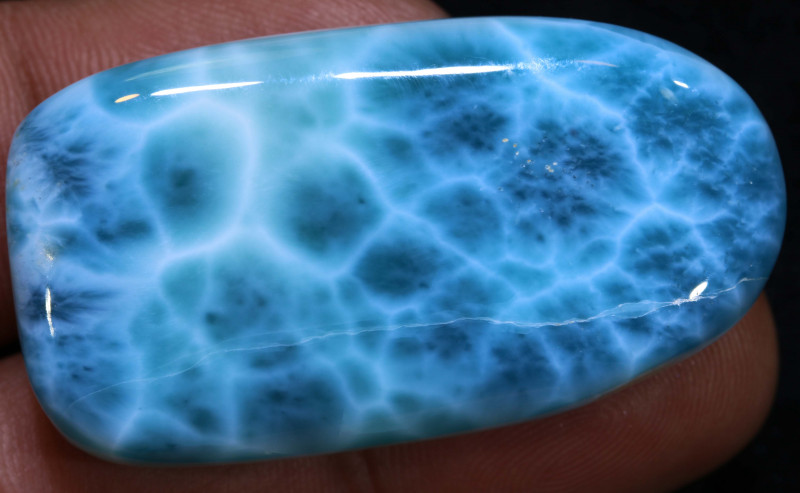
What Is Larimar?
Larimar is a semi-precious gemstone with cloudy whites and blues that reflect its Caribbean origin. Appropriately, nicknames for larimar include:
Gem of the Caribbean
Atlantis Stone
Stefilia’s Stone
Dolphin Stone
Mermaid Stone
These stones may resemble amazonite, turquoise, or blue jade. In place of turquoise, larimar can substitute as a December birthstone or an 11th wedding anniversary gemstone! Those born under Leo are graced with larimar as their zodiac stone.

Larimar Specifications & Characteristics
Pectolite is a hydrated sodium calcium silicate. In larimar, the calcium is usually partly replaced by copper or cobalt and the stone tends to have much less sodium. Iron or manganese may be present as well.
Larimar has a fibrous structure, filled with tightly packed, intertwined crystals that makes it more durable. The fibers vary in toughness, making some stones more durable than others.
Speaking of durability, larimar’s hardness on the Mohs scale is usually 4.5 to 5, but deep blue sections can be as hard as quartz (7). White sections are softer.
These gems have a smooth, silky texture. Plus, larimar is easier to cut and handle than pectolite because it lacks pectolite’s splintery crystal needles.
Below are all the larimar stone properties:
Color: White, sky blue, deep blue, blue-green; Sometimes colorless sections
Crystal structure: Triclinic
Luster: Vitreous (glass-like), subvitreous, or silky
Transparency: Opaque, sometimes with translucent patches
Refractive index: 1.59-1.64
Density: 2.62-2.90
Cleavage: Perfect on [100] and [001] (crystal form); None when compact
Fracture: Uneven
Streak: White
Luminescence: Sometimes fluorescence - Greenish-yellow or orange in SW-UV (strong) & LW-UV (moderate); Sometimes triboluminescence (friction-induced); Compact form - thermoluminescent (heat-induced)
Optical effects: Sometimes chatoyancy
Ready to learn the metaphysical properties of larimar? Let’s start with what larimar symbolizes.

Larimar Mining Update
As of May 2022, the Larimar mines in the Dominican Republic have been closed indefinitely due to health and safety concerns involoving poisonous gas in the mines. As a result the price of Larimar is skyrocketing and at the same time there is a tonne of fake material from China entering the market. Scroll down to see how to tell a real and fake piece of Larimar.
Larimar Meaning & History
Continuing the maritime connections, larimar symbolizes the tranquility and clarity of the sea and sky. Moreover, the stone represents heavenly energy and balancing feelings with thoughts.
The nickname “Atlantis Stone” ties into larimar’s folklore. Local legends claim it came from the sea. Fascinatingly, famous American clairvoyant Edgar Cayce predicted in 1910 the discovery of a blue gem on a Caribbean island. Cayce also (falsely) predicted that Atlantis would be discovered in the Caribbean by the 1960s.
Indeed, many believe this Dominican Republic stone is a remnant of the mythical underwater city of Atlantis. Likewise, some say larimar contains Atlantis’s “ancient wisdom.”
Larimar isn’t an ancient stone, though; in fact, it’s a modern find!

Older History
Larimar’s specific location is in Hispaniola, the first island Christopher Columbus landed on in his infamous 1492 voyage.
Before Columbus, the indigenous Taíno people probably knew about larimar for centuries. Tragically, Columbus and other Spaniards wiped out most of the Taíno population, some sources estimating 85 percent gone by 1514.
Flash forward to 1916.
Another Spaniard, Father Miguel Domingo Fuertes Loren, strolled along the shores and stumbled across a unique blue rock. Locals told him these stones were gifts from the ocean.
Not only a priest but a naturalist, Fuertes requested government permission to look more and start mining, but they denied the request.
No more records mention larimar until 1957, when residents of a fishing village found larimar fragments on the beach (likely Barahona Beach). Some villagers spent days going upstream along the river to find more larimar stones.
Modern History & First Official Discovery
Finally, the first official discovery of larimar occurred in 1974.
A Santo Domingo jeweler, Miguel Méndez, had a customer bring in the stone for him to craft a bracelet, telling him she found it on Barahona Beach. Méndez thought nearby mountains were more likely the original source.
Alongside Peace Corps volunteer Normal Rilling, Méndez ventured out and eventually found the main larimar deposit further inland in the Bahoruco Mountain Range. This site became the Los Chupaderos mine.
The first name for larimar was Travelina, but Méndez changed it to a portmanteau of Larissa, his oldest daughter’s name, and mar, the Spanish word for “sea.”
Luckily, we don’t have to traverse mountains and rivers to experience the benefits of larimar gems. On that note, what is larimar good for?

Larimar Stone Healing Properties
Larimar, like all gemstones, has many properties as a healing stone. For one, its place as a blue gemstone means it inherently can provide calming effects.
Plus, blue gems are chakra stones for the throat chakra, so wearing larimar jewelry can help you embrace your truth and speak it confidently.
Additionally, energy healers use the gem for attracting or enhancing true love. Meditating with a larimar soulmate stone is believed to help you find your soulmate or encourage deeper connections with your soulmate if you already found them!
What about more individual physical and emotional larimar benefits?
Physical Healing
Some abilities attributed to larimar include:
Treating throat problems
Improving fertility
Lowering fevers
Relieving headaches
Onto larimar’s emotional uses!
Emotional Healing
Larimar crystal is said to treat irrational anxieties or phobias, particularly for flying. Many use it for accessing spiritual wisdom and dispelling self-doubt.
Because larimar comes from volcanoes, some crystal healers recommend it for emotional balance when your feelings seem unpredictable or eruptive.
Next, we’ll discuss what factors into each larimar stone’s value.

Larimar Gemstone Properties
Wondering how to determine the quality of larimar? The value factors to look at are color, pattern, cut, and size.
Color
Larimar can be white, blue, teal, or green. Green larimar stones are usually light gray-green and not desirable unless they display deeper hues alongside deep blue.
The rarest, most valuable color is deep blue, dubbed “volcano blue.” Sky blue larimar is most popular. The least valuable but most abundant color is light blue.
What causes the blue is somewhat unclear. Many think it’s copper, but studies have shown the blue areas don’t always have high copper concentrations; they’re often lower than copper concentrations in white portions.
Vanadium is another possibility, but it’s likely a combination of factors.
What we do know are many of the common inclusions behind larimar’s exciting patterns.
Patterns
You’ll rarely if ever find larimar without a pattern, be it speckles, wisps, veins, or spots. Most often, it has a blue base with white splotches or lines of pectolite. A deep blue larimar with white ribbons is most valuable.
Other possible colors are green, brown, or red. Reddish-brown or black comes from hematite (often in feather shapes) but iron oxidation can also cause red. Common patterns include speckles, wisps, veins, and spots.
Some colors mixing in are undesirable, creating “stains” that lower the larimar's value.
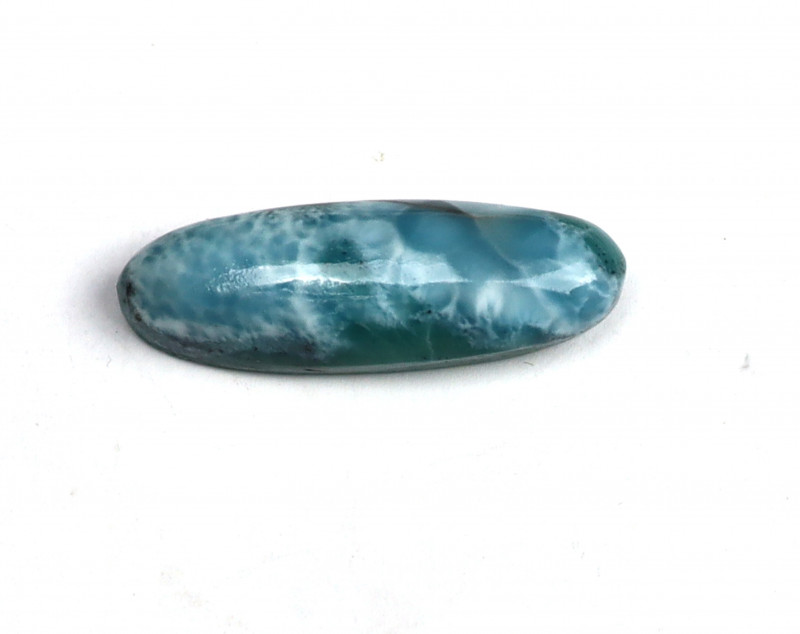 Image: "Volcanic blue" larimar cabochon
Image: "Volcanic blue" larimar cabochon
Cut
Larimar is prone to breakage during cutting, so it’s only occasionally faceted.
Some popular cuts are larimar beads, carvings, and polished freeform stones. Most often, the final cut is a large cabochon, though each cabochon’s shape may vary.
Size
Size works in tandem with larimar’s color and cut. Large cabochons with a cushion or dome display deeper blues better, whereas smaller (or thinner-cut) stones are usually paler and more translucent.
Larimar stones are available in a range of sizes.
Fake Larimar
Fake larimar gems are fairly prevalent. Some jewelers estimate about half the larimar on the market is fake, much higher for beads.
Imposters are typically similar-looking stones (simulants) like quartz, amazonite, or dyed howlite. Recently there has been a huge increase of glass that looks very similar to Larimar entering the market.
How can you tell a fake larimar from the real deal?
The idea that no light will pass through larimar is false. Some are slightly translucent, especially thin-cut slabs.
Some identification tests are:
Pattern. Real larimar always has white patterns.
Color Consistency. Dyed simulants tend to have greener, more uniform coloring.
Appearance. Most fakes are made using glass. Check out the images below which give you an idea on what this glass looks like before they cut it up into fake Larimar pieces.
Images Of Fake Larimar

 So, how does real larimar form?
So, how does real larimar form?
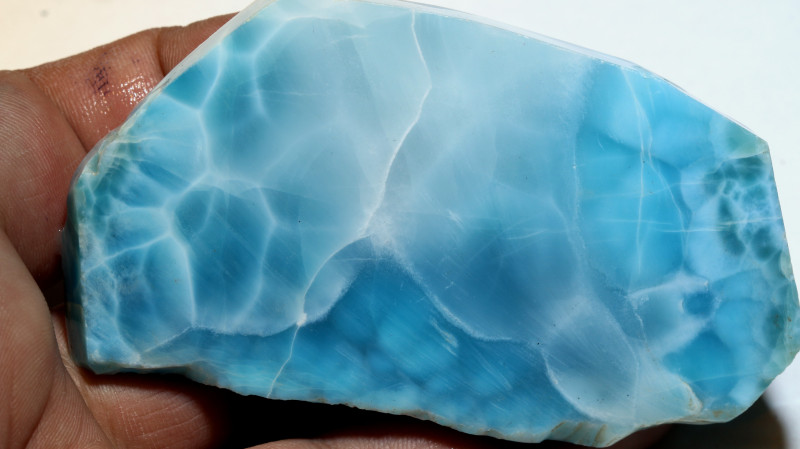
Larimar Formation & Sources
We’ve mentioned the volcanic larimar properties, but the Dominican Republic doesn’t have active volcanoes, so what’s the deal?
Active volcanoes did exist there millions of years ago; in fact, volcanic activity and tectonic plates shifting created the Caribbean islands! This period is also when larimar started forming.
The intense conditions caused magma to rise up toward Earth’s surface, gradually cooling and hardening into rocks. Overlapping layers of magma and gasses escaping from them created empty spaces for mineral-rich water to fill.
As the water began evaporating, tiny balls of radiating crystal fibers called spherulites formed. The spherulites merged into a gel and hardened, becoming larimar. Some studies suggest the blue portions cooled quickly, while the white portions cooled slowly.
Many of the rocks containing larimar, largely andesite or basalt rocks, eroded, loosening the larimar inside. This allowed water to bring them down streambeds to beaches, naturally tumbling and polishing them along the way.
Mining Locations
The mountainside where Méndez and Rilling found the original larimar outcrop soon became the Los Chupaderos mine (now the Filipinas Mine).
Where is larimar found today? The same area! The mine only covers half a square mile, and locals hand-dig for larimar.
Dominican Republic larimar mining rights legally must belong (at least partly) to locals. This type of individual, small-scale mining is called “artisan mining” and the profits all go back to their community!

Larimar Price & Value
Many larimar stones or jewelry are sold locally in the Caribbean, but larimar prices can vary broadly by location. Remember: Larimars with deep blue coloring or sharp color-contrast fetch the highest prices.
Faceted larimar gemstones are rare and typically go for $20-$30 per carat.
Here are the general wholesale prices for larimar cabochons we sell here at Gem Rock Auctions:
High-quality cabochons: $3-$20 per carat
Lower-quality cabochons: $0.14-$3 per carat
Next, we’ll break down our larimar jewelry wholesale prices:
Larimar Rings: $0.80-$2.15 per carat
Larimar Earrings: $0.15-$0.95 per carat
Larimar Necklaces: $0.40-$0.70 per carat
Larimar Bracelets: $20-$70 each
Lastly, raw larimar is around $5 for high-quality and $0.15-$1 for lower-quality pieces.
Larimar Care and Maintenance
Knowing proper gemstone care for larimar is important to maintain its color and integrity. When choosing jewelry, we recommend protective settings for a larimar ring or bracelet.
Larimar is sensitive to direct light and heat, so prolonged exposure to either will cause color-fading. Avoid wearing larimar jewelry outside on hot, sunny days. Conversely, leaving larimar submerged in water may cause darkening.
Use a soft cloth and lukewarm water to clean larimar. Keep it away from strong chemicals.
Remove larimar jewelry before any strenuous activities. Keep the stone in a velvet pouch or fabric-lined box, stored in a cool, dark place away from other gems.
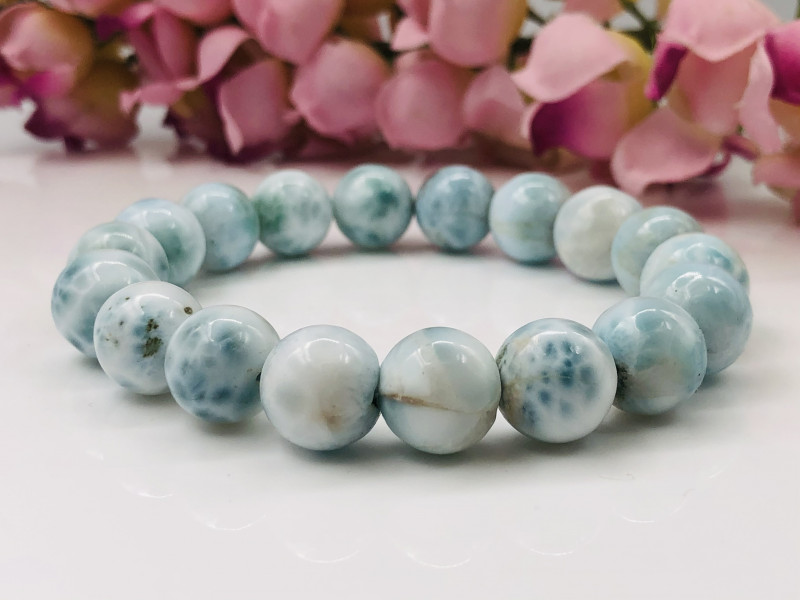
Carry the Caribbean Spirit with Larimar!
Visiting local jewelry shops to find larimar gems is a must for any trip to the Dominican Republic. Luckily, you can bring larimar’s Caribbean beauty and vibes to your front door without traveling at all!
Very few gems come from the Caribbean, so it’s only fitting that larimar embodies the locale’s many captivating traits.
To quote award-winning poet and Caribbean native Derek Walcott: "I come from a place that likes grandeur… it is not inhibited by flourish… it is a society of style.”
Search the Gemstone Encyclopedia
Related Auctions
Related Articles
Originally the Birthstones or gemstones were associated with a zodiac sign or the month of a individuals birth. Find out what your stone is and view the stones we have for sale
8th Feb 2021
There are dozens of quartz and chalcedony gems with various colors and patterns. Learn all about quartz properties and every type of quartz, from amethyst and agate to plasma and phantom quartz!
15th Oct 2020
Hackmanite is a pink to violet sodalite gem known for its unique color-change and luminescence. Learn why hackmanite is special, from its rare qualities to the types of hackmanite jewelry available.
28th Mar 2018
Latest Articles
Shortite is a rare mineral and rarer gemstone, usually found as colorless or yellow wedge-shaped crystals. Learn the value, history, and properties of shortite in this guide!
9th Dec 2024
Senarmontite is an uncommon antimony mineral mostly used industrially but occasionally collected as rare gems or pearly crystals. Find out all of the traits, uses, prices, and history of senarmontite.
27th Nov 2024
Tantalite is a group of red, brown, or black minerals containing the rare and valuable element tantalum. Discover the uses, history, prices, and properties of tantalite gemstones in this guide!
11th Nov 2024
Article Categories
How To's is where you will find helpful articles from gem Rock Auctions on how to cut gemstones, select gemstones and buy gemstones.
9 Articles





